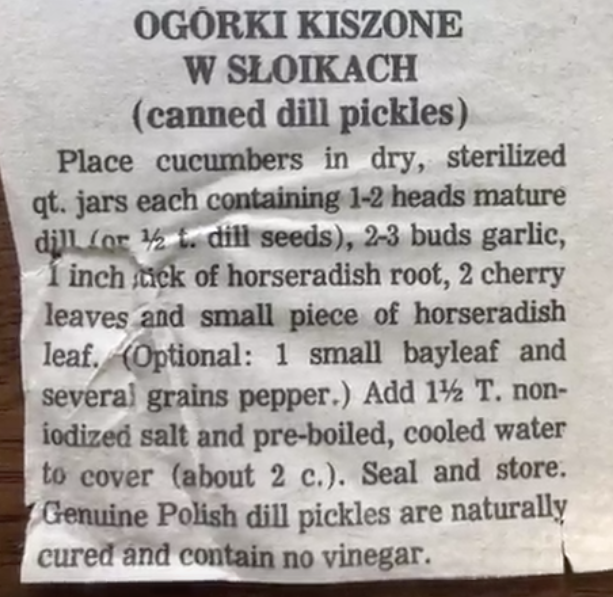"Ogórki Kiszone w Słoikach"
Terry and Greg Kopec (with the help of Anna Muller and Taylor Lenze)
The sweet crunch of “ogórki kiszone w słoikach,” polish dill pickles, is a tangible link for the Kopec family between their modern life in Michigan and their Polish heritage. “I remember when we were dating my mother-in-law making those pickles,” Terry Kopec says. “I remember duck blood soup, czarnina, tongue sandwiches, pierogi, and potatoes pancackes, etc. My husband had these all the time growing up.”
Now Terry and her husband have these recipes, passed down by Terry’s mother-in-law’s own mother-in-law. Carefully hand-written on small white index cards, the instructions are in English rather than Polish, perhaps an attempt to help Terry cook but also a concrete reminder of the space between the Poles who brought the foods to the new land and those who eat the dishes now.
The Kopec family is trying to overcome this distance however. Terry and her husband were married 1971. Though not Polish herself, she has been adopted into the tradition and helped her husband search for his ancestry. Scattered artifacts, like the family recipes or a pickle recipes from the south eastern part of Bay City paper in the 1940s, offered tantalizing clues about his forefathers’ lives in Poland, but at first there was little they knew concretely.
Finally they decided the only way to really learn was to go themselves, back to the land of their ancestors. Terry explains: “this past fall we took a trip to Eastern Europe, especially to go to Poland so my husband and his brother could check out their heritage. We spent time in Warsaw, Krakow and drove down to southern Poland. Unfortunately, we didn't get over to Srem, Poland on the western side.”
Srem was important to the family because Terry’s husband’s great grandfather, Jozef Kopec, was born in the area on March 14th, 1836. He became a blacksmith and married Jozefa Novak (Nowaczyk), born in 1836 near Czerwona Wieś, a town only around 20 km away. Together “they had five children. Their second child, Ignatius William (my husband's grandfather), born in Srem, Poland on July 31st 1877.”
When Ignatius was only five years old, the family made the decision to immigrate to the United States. It’s not clear what motivated this decision. The young family with at least two young children already must have faced fears and hardships on the ship journey across the Atlantic and upon first arriving in the new land. One causality of the move was Jozefa’s name. “We aren't sure of all the original names as some were changed when they came to America,” Terry explains. Hence, though the American spelling is “Novak,” it’s possible that the original was “Nowaczyk.”
Jozefa died in 1933 at the age of 97, 17 years after her husband. Ignatius also lived a long life, passing away at 92 years old in 1971. His life in the US was full and prosperous. “He owned a hardware and sporting goods store in Bay City, MI,” Terry recalls. At 31, on February 9th 1908 he married Margaret Stupak. “He and his wife had 8 children. My husband's dad was Harold Zigmond Kopec. These facts are accurate to the best of our ability from family and records.”
Records and figuring out the truth of their family history is important to the Kopec family. Part of the success of the trip to Poland was simply in learning how to “read” the Polish clues all around them. Terry explains the moment they started learning about the Poles whose names guide one through the streets and landmarks of the family’s hometown in Michigan. “I don't know if you have ever been to Bay City, MI. But the eastern side of the city is like a little Poland. My husband got so excited when we were in Warsaw because of all the names. My husband grew up around St. Hedwig's and St. Stanislaus Churches. There was Pulaski Park and Kosciuszko Street in Warsaw, we saw many famous statues name Zigmund and Ladislaus, all names all over Bay City. In Poland, he read all about these famous people whose streets, parks, halls and churches where he grew up, were named after. It was pretty cool!”
Bay City, though physically far removed from Poland, is alive for the Kopec family with touchstones of their Polish past. Be it Polish hymns at St. Hedwig's and St. Stanislaus Churches, physical landmarks named for Poles who the family now recognize, Polish dill pickle recipes in the city paper, or the family’s own heirloom Polish recipes, so carefully preserved for each new generation, each piece of Polish identity allows the family to come closer to their roots and cherish their family’s ancestry.
